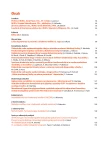„Customization of the insulin therapy in patient“: a case report
Authors:
Zbynek Schroner
Authors‘ workplace:
Schroner MED s. r. o., interná a diabetologická ambulancia, Košice
Published in:
Forum Diab 2013; 2(2): 122-124
Category:
Overview
Current opinion of the American Diabetes Association and the European Association for the Study of Diabetes (ADA / EASD) recommends personalized approach in treatment reflecting the needs, preferences and tolerances of each patient, thus individualization of therapy. The management of 81-years old polymorbid patient with diabetes mellitus type 2 in this case report confirms the therapeutic tendency. Thus in this case, the use of premixed insulin analogues.
Key words:
diabetes mellitus type 2 – intensified insulin regimen – insulin lispro mix – premixed insulin analogues
Sources
1. Donner T, Muňoz M. Update on insulin therapy for type 2 diabetes. J Clin Endocrinol Metab 2012; 97(5): 1405–1413.
2. Hirsch IB. Insulin analogues. N Engl J Med, 2005, 352(2): 174–183.
3. Inzuchci SE, Bergenstal RM, Buse JB et al. Management of hyperglycemia in type 2 diabetes: a patient-centered approach. Position Statement of the American Diabetes Association (ADA) and the European Association for the Study of Diabetes (EASD). Diabetologia 2012; 55(6): 1577–1596.
4. Schroner Z. Súčasnosť a perspektívy inzulínovej liečby. Interná Med 2007; 7(1): 7–15.
5. Uličiansky V, Schroner Z. Čo prináša najnovšie stanovisko (Position Statement) Americkej diabetologickej asociácie (ADA) a Európskej asociácie pre štúdium diabetu (EASD) pre klinickú prax? Interná Med 2012; 4(12): 154–161.
Labels
Diabetology Endocrinology Internal medicineArticle was published in
Forum Diabetologicum

2013 Issue 2
Most read in this issue
- Diabetic neuropathy: clinical features and contemporary possibilities of diagnostics and treatment
- Management of hypertriacylglycerolaemia from the point view of newest guidelines of The Endocrine Society
- Diabetic nephropathy: epidemiology and diagnosis
- Pathophysiological aspects of diabetic foot syndrome
